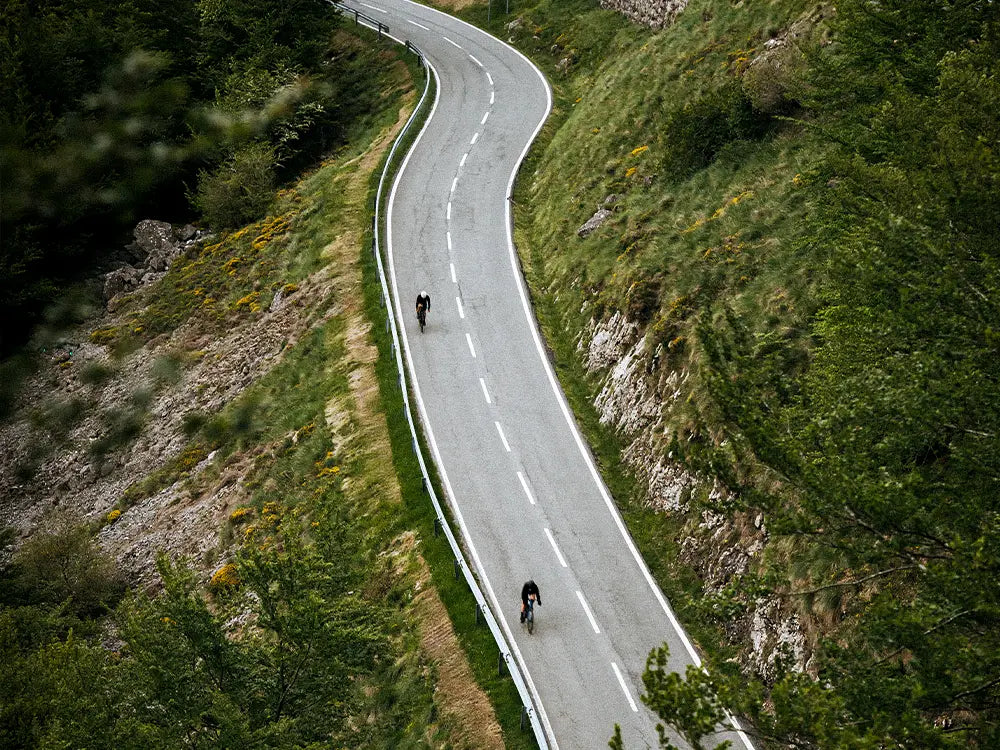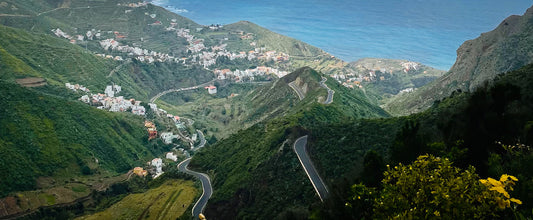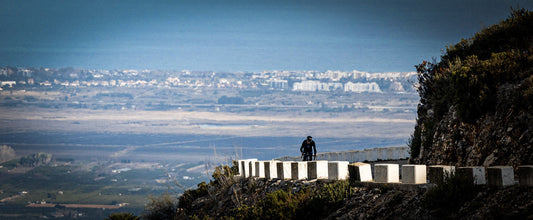In the first chapter of the "Cycling Gateway by Gobik" section, we present a small guide to enjoy the Pyrenees with your bike.
Pyrenees and cycling are historically linked. The greatest achievements in the history of cycling have been written in its mountains, the mystique of these passes makes you feel an unparalleled magic while your eyes are overwhelmed by the breathtaking views offered by its peaks.
Although the list of climbs in the Pyrenees could be practically infinite, in this chapter we will focus on the best known areas of the French Pyrenees: Pyrenees Ariégoises, Pyrenees Orientals and Pyrenees Atlantiques.
Pyrenees Ariégeoises
Entering France through the border with Puigcerdà or Andorra, we find the Ariege region, an area with beautiful mountain passes less than 3 hours by car from Barcelona. Undoubtedly the best option for a weekend getaway.
Ax Les Thermes
The ideal accommodation in Ariege is undoubtedly Ax Les Thermes. A thermal village with a lot of charm. Its spas are undoubtedly a great plan to recover in the afternoon after a morning of cycling. Through the streets of the village you will find natural hot springs at different temperatures where people take the opportunity to relax.
Where to eat in AX Les Thermes?
Le Cave. Cafeteria - Restaurant with local dishes, we recommend you to try their hamburgers and steak tartar.
Where to have a coffee at AX Les Thermes?
Cafeteria Le Grand Café. On the main road of the village we find a very authentic coffee shop, with typical regional pastries.
Routes from AX Les Thermes:
Route 1 Col des Ares + Col du Palhieres: A circular route where, after crowning Col des Ares after a climb of 8km on a very narrow road and irregular asphalt, we will descend to Querigut, where we will begin the ascent to one of the most legendary passes of the Tour de France: Col du Palhieres. Its 18 km at 7% average gradient are witnesses of the greatest feats of cycling, the hardness of the first part of the port is rewarded with the last 4km, where the views over 2000m are incredible.
Route 2 There is a popular legend that says that whoever wins on Plateau de Beille wins the Tour. So it was with Pantani, Contador, Armstrong and this 2024 with Pogacar. One of the hardest climbs in the Pyrenees that we will start from Les Cabanes after passing Col du Portet and Col du Marmare. Its first 3 km at more than 10% average already warn us that it will not be an easy climb. However, from km 10 onwards the slope becomes much gentler and you can enjoy the wonderful views at an altitude of more than 2200m. At the top, you will find a large esplanade where you can rest and enjoy nature.
Pyrenees Orientals
Undoubtedly the most famous region for cyclists, the emblematic Tourmalet, roof of the Pyrenees and undoubtedly the most mythical climb of the Tour de France, governs the chain of mountains that surround this incredible region.
To enjoy them, we have two very clear options to stay: St Lary Soulan and Luz Saint Sauveur.
St Lary Soulan.
Located in the heart of the French Pyrenees, it is an emblematic destination for cyclists due to its proximity to some of the most challenging and famous passes of the Tour de France, such as the Col de Peyresourde, the Col d'Azet and the Col de Portet. This charming mountain village offers cycling routes that combine demanding climbs with spectacular scenery, attracting both professional and amateur cyclists. In addition to its cycling connection, Saint-Lary-Soulan is known for its thermal baths, its cozy alpine atmosphere and its wide range of outdoor activities, making it an ideal place to enjoy nature and Pyrenean culture.
Where to eat in St Lary Soulan?
La Grange Very authentic restaurant with a traditional gastronomic offer and a very cozy atmosphere with an outdoor garden.
Where to have coffee in St Lary Soulan?
Mumú Café. Specialty coffee shop in the village square with a wide variety of sweets typical of the region.
Manivelle Café (Arreau) : A highly recommended cafe as a "pit stop" during the route Aspin, Tourmalet, Horquette in Arreau (at the foot of Tourmalet).
Routes from St Lary Soulan
Route 1 Aspin, Tourmalet, Horquette d'Anzizan. The most famous loop in the Pyrenees. The ramps of the Col d'Aspin (12 km, 6.5%) will serve as a prelude before crowning one of the most mystical passes of the Tour: the dreaded Col du Tourmalet. 17 km at almost 9% average gradient that will take you to the extreme, with its hardest part in the section of "Les Galeries", 3 endless km at more than 11% average gradient and with ramps up to 20%. Once crowned and made the obligatory photo at the statue of Henry Desgrange, we will descend the same slope to return to St Lary Soulan by Horquette d'Anzizan, a beautiful port of 8km at 5% with stunning views at its highest part.
Route 2 Peyresourde, Col d'Azet, Col du Portet. Starting in St Lary Soulan, after up to Loudenville, we climb the Peyresourde (13.7km, 7.1% average gradient), a pass known among other feats for Chris Froome's victory in 2016. We return to St Lary via Col d'Azet (7.4 km at 8.3%) where, as the final course, we face the challenging Col du Portet (16 km, 8.7%), a "new" pass as it was asphalted in 2020 for the Tour and was the scene of Tadej Pogačar's victory in 2021. During the descent of Col du Portet, we can detour to climb up to Pla d'Adet (5 km at 7%) and contemplate the views all the way down the valley.
Light St Sauveur.
A picturesque village in the French Pyrenees, it is an ideal destination for cyclists, thanks to its proximity to several legendary Tour de France passes, such as the Col du Tourmalet (annexed to the village, Hautacam or Luz Ardiden. In addition to its cycling reputation, Luz-Saint-Sauveur boasts thermal spas, a welcoming atmosphere and a rich cultural heritage, providing a perfect base for exploring the natural beauty and traditions of the Pyrenees.
Where to eat in Luz St Sauveur?
Luz Et Coutumes Very authentic traditional restaurant where you can taste the best dishes of the region.
Where to have coffee in Luz St Sauveur?
La TerrasseCafeteria / Restaurant in Luz St Sauveur with a large terrace in front of the village square. The ideal place to start your walks.
Routes from Luz St Sauveur:
Route 1 Tourmalet, Hautacam, Luz Ardiden. One of the most iconic and challenging of the French Pyrenees.From Luz Saint Sauveur, we start the mythical ascent Col du Tourmalet , one of the most emblematic passes of the Tour de France, with a length of 19 km and an average gradient of 7.4%. This pass has been the scene of historic feats, such as the impressive victory of Octave Lapize in 1910, who became the first cyclist to cross the Tourmalet in the Tour de France, and the memorable battle between Lance Armstrong and Marco Pantani in 2000. The route continues to Hautacam, with a climb of 13.6 km and an average gradient of 7.8% whose ramps have seen the exploits of Indurain, Bjarne Riis or Vincenzo Nibali. Finally, we reach Luz Ardiden, with a length of 14.7 km and an average gradient of 6.9%, famous for its numerous hairpin bends and beautiful views of the surrounding valleys, another pass known for great feats such as Lance Armstrong's exhibition in 2003 or Bernard Hinault's victory in 1985 after a hard fall.
Route 2 Cirque de Gavernie + Col de Tentes + Cirque de Tromouse. Starting at the impressive Cirque de Gavarnie, a glacial cirque declared World Heritage Site by UNESCO. From here, we climb the Col de Tentes, with a length of 11 km and an average gradient of 7.8%, known for its impressive altitude and panoramic views. This pass has witnessed memorable feats, such as the ascent by Spanish cyclist Marino Lejarreta in the 1983 Vuelta a España. For those looking for an additional challenge, the route can be extended to the Cirque de Troumouse, a demanding climb but rewarded with some of the most breathtaking scenery in the Pyrenees, culminating a great day's cycling.
Pyrenees Atlantiques
The Western Pyrenees, or Pyrenees Atlantiques, are an iconic destination for cycling enthusiasts. With mythical summits such as Col d'Aubisque and Col de Marie-Blanque, which have written several pages of Tour de France history. In addition to being a paradise for cyclists, the Western Pyrenees offer a wealth of natural and cultural riches, with sites to visit such as the Pyrenees National Park, the historic town of Lourdes and the picturesque Aspe Valley.
Laruns
A charming village in the Atlantic Pyrenees with easy access to iconic passes such as the Col d'Aubisque, Col de Marie-Blanque and Col du Soulor- Laruns is also perfect for hiking, with routes exploring the Pyrenees National Park, and adventure activities such as climbing, rafting and canyoning. You can also relax in the thermal baths of Eaux-Bonnes and enjoy the rich gastronomy and culture of the area.
Where to eat in Laruns?
L'Escapade If you like meat, this is the ideal place to recharge your batteries. Traditional brasserie with a large terrace very cozy in summer.
Where to drink Laruns coffee?
Ossau Mets Boulangerie : Typical French boulangerie with a great variety of pastries and a small terrace.
Routes from Laruns:
Route 1 Col d'Aubisque and Col de Spandelles. Starting from Laruns, we ascend the legendary Col d'Aubisque, 16.6 km long and with an average gradient of 7.2%. This pass has been the scene of countless feats in the Tour de France, such as Louison Bobet's epic victory in 1953, the route continues to the Col de Spandelles, a pass recently known for Jonas Vingegaard's attack on Tadej Pogacar in 2022, with 10.3 km in length and an average gradient of 8.3%, offering an additional challenge with its steep gradients and spectacular views.
Route 2 Marie Blanc and Solour: Starting in the quiet valley of Bielle, we ascend the challenging Col de Marie-Blanque, 9.3 km long and with an average gradient of 7.7%, known for its steep ramps in the last kilometers. This pass has been the scene of memorable feats, such as Miguel Induráin's impressive ascent in the 1992 Tour de France, leaving all his rivals behind. Once crowned, the route continues to the Col du Soulor, 7.5 km long and with an average gradient of 8.4%, offering an additional challenge with its incredible views from the top.
Larrau
Located in the French Basque Country, it is an outstanding destination for cyclists due to its access to mythical passes such as the Col de Larrau or La Pierre San Martin. This small village offers an authentic mountain biking experience, surrounded by spectacular scenery and unspoiled nature. In addition to its cycling appeal, Larrau is ideal for hiking, with routes exploring the stunning Irati Forest, and offers adventure activities such as kayaking and rafting on nearby rivers. The town's rich Basque culture is reflected in its gastronomy and festivities, providing a culturally enriching stay full of outdoor activities.
Where to eat in Larrau?
Etchemaité Included in the Michelin guide, an ideal option to enjoy Basque-French gastronomy with a large terrace.
Where to have coffee in Larrau?
Boulangerie Dagassan Typical Boulangerie with coffee option, small but cozy place.
Routes from Larrau.
Route 1 Port de Larrau - Col d'Organbideska - Irati - Arthaburu. Starting in the valley of Larrau, we ascend to the imposing Port de Larrau, 14.2 km long and with an average gradient of 8%, known for its toughness and the breathtaking views it offers. This pass was the scene of a memorable feat by Marco Pantani in the 1996 Tour of Spain, where his fierce attack left his rivals behind in one of the hardest stages of that edition. We will then climb the Col d'Organbideska, 9.5 km long and with an average gradient of 7.4%, a tough climb with horseshoe bends that give it a mystical touch and will take us to the magical village of Irati. From there, we return to Larrau by Col de Arthaburu and its very hard ramps (10 km at 9%).
Route 2 Route 2: Larrau - St Jean Pied du Port - Larrau. We will head to Saint-Jean-Pied-de-Port after passing the Col de Bagargui, a tough climb of 9 km at 8% average with spectacular views from the top. Once crowned, we descend to St Jean Pied Du Port, a place of worship for pilgrims on the Camino de Santiago and a visit to the monastery is a must. From St Jean, we return to Larrau by the dreaded Col de Arthaburu and its 10 km at 9% average gradient.
We hope this complete guide will help you to discover the Pyrenees with your bike, see you on the roads!













